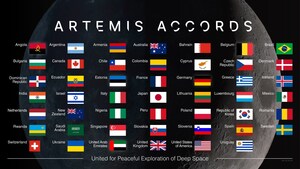WASHINGTON, Nov. 20, 2013 /PRNewswire-USNewswire/ -- NASA is beginning to receive confirmation 11 small cubesat research satellites, including the first developed by high school students, that were launched into space Tuesday night from the Virginia coast are operating as planned.
(Logo: http://photos.prnewswire.com/prnh/20081007/38461LOGO)
The cubesats were included as auxiliary payloads aboard a U.S. Air Force Minotaur 1 rocket that lifted off from the Mid-Atlantic Regional Spaceport at NASA's Wallops Flight Facility at 8:15 p.m. EST. The cubesats, NASA's fourth Educational Launch of Nanosatellite (ELaNa) mission, deployed from their protective cases into Earth's orbit about 20 minutes after liftoff.
As the miniature satellites come online, the teams responsible for them are beginning to receive signals. Although it could take several more days for full confirmation, all of the cubesats appear to be doing well in their new home in low-Earth orbit. The teams are responsible for confirming activation and normal operations of the cubesats.
''Cubesats offer our best and brightest young minds the opportunity to discover the excitement of space exploration while confronting the tough technology and engineering challenges surrounding spaceflight," said Leland Melvin, NASA's associate administrator for education in Washington. "By opening the space frontier to a new generation of scientists and engineers, we encourage students to pursue careers in science, technology, engineering and mathematics."
Cubesats are a class of research spacecraft called nanosatellites. The cube-shaped satellites measure about 4 inches on each side, have a volume of about 1 quart and weigh less than 3 pounds. Cubesat research addresses science, exploration, technology development, education or space missions.
"The advancements of the cubesat community are enabling an acceleration of flight-qualified technology that will ripple through the aerospace industry," said Jason Crusan, director of NASA's Advanced Exploration Systems Division, which oversees the CubeSat Launch Initiative. "Our future missions will be standing on the developments the cubesat community has enabled."
Cubesats from nine universities, a NASA center and a high school were launched. The TJ3Sat from Thomas Jefferson High School for Science and Technology of Alexandria, Va., contains a voice synthesizer module that will take written phrases in the form of code and produce a phonetic voice reading on the satellite's downlink frequencies. TJ3Sat is the first NASA-sponsored cubesat developed by high school students.
Also sent into orbit was PhoneSat 2.4, a second-generation smartphone cubesat mission sponsored by NASA's Space Technology Mission Directorate. Phonesat 2.4 will test the smartphone's capability as communication technology for nanosatellites and as hardware to manage pointing, taking images and software execution. PhoneSat 2.4 has several improvements over the previous mission, including a two-way radio to enable command of the satellite from the ground, solar arrays to enable it to be operational for up to a year, and a system for attitude control.
More than 300 students from the following institutions were involved in preparing the 11 cubesats:
- Thomas Jefferson High School
- Drexel University, Philadelphia, in collaboration with the United States Naval Academy
- NASA's Ames Research Center, Moffett Field, Calif.
- St. Louis University, St. Louis
- University of Alabama, Huntsville, Ala.,
- University of Florida, Gainesville, Fla.
- University of Hawaii, Honolulu
- University of Kentucky, Lexington, Ky., in collaboration with Morehead State University, Morehead, Ky.
- The University of Louisiana, Lafayette, La.
- University of New Mexico, Albuquerque, N.M.
- Vermont Technical College, Randolph Center, Vt.
The launch also marks the first flight of the Nanosatellite Launch Adapter System (NLAS), a satellite deployment system built by Ames. NLAS is capable of carrying approximately 100 pounds of secondary payloads into orbit, and can accommodate various configurations of cubesats.
ELaNa missions, conducted under NASA's CubeSat Launch Initiative, give students, teachers and faculty hands-on experience developing flight hardware by providing access to a low-cost avenue for research. Since its inception in 2010, the CubeSat Launch Initiative has selected more than 90 cubesats from primarily educational and government institutions around the United States. NASA chose these miniature satellites from respondents to public announcements for the agency's CubeSat Launch Initiative. NASA has a current call for proposals due Nov. 26.
For additional information about NASA's CubeSat Launch Initiative, visit:
http://go.nasa.gov/CubeSat_initiative
For additional information about ELaNa 4, visit:
http://go.nasa.gov/18i2YFk
For more information about NASA's PhoneSat 2.4 mission, visit:
http://go.usa.gov/WQSA
SOURCE NASA
WANT YOUR COMPANY'S NEWS FEATURED ON PRNEWSWIRE.COM?
Newsrooms &
Influencers
Digital Media
Outlets
Journalists
Opted In





Share this article